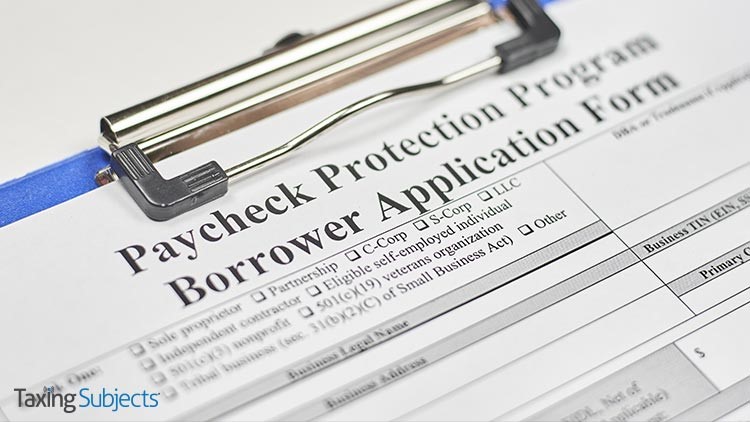by | Oct 3, 2020 | Tax Tips and News
The Internal Revenue Service closed out September by announcing the publication of final regulations for the business-related entertainment deductions that were removed from section 274 by the Tax Cuts and Jobs Act.
Corporations celebrated the new 21 percent tax rate and small businesses took advantage of the section 199A qualified business deduction, but the TCJA elimination of “entertainment, amusement, or recreation activities” was a far less popular change.
Business relationships are like any other relationship: shaped by shared experiences. That’s why taking clients and potential business partners to concerts and baseball games as part of a business discussion was long seen as an essential part of sealing a deal. Despite the removal of most such deductions in the TCJA, some still remain.
What business entertainment deductions can taxpayers still claim?
The IRS points out in the final regulations that “Congress did not amend the provisions relating to the deductibility of business meals. Thus, taxpayers generally may continue to deduct 50 percent of the food and beverage expenses associated with operating their trade or business, including meals consumed by employees on work travel” (TD-9925, 5).
Since the TCJA didn’t make changes to business meals, the old restrictions still apply: “No deduction is allowed for the expense of any food or beverages unless (a) the expense is not lavish or extravagant under the circumstances, and (b) the taxpayer (or an employee of the taxpayer) is present at the furnishing of the food or beverages” (5).
To learn more about which business entertainment deductions are and are not allowed, check out the TD-9925. The IRS also recommends taking a look at their “Tax Reform” page for a broad overview of all TCJA-related changes.
Want to read about other final regulations?
Source: IR-2020-225
– Story provided by TaxingSubjects.com
by | Oct 2, 2020 | Tax Tips and News
Final regulations for the default rate of individual income withholding for certain periodic retirement and annuity payments that are made in 2021 are now available. The Internal Revenue Service announced the document’s publication this week, adding to the growing list of recently published final regulations related to the Tax Cuts and Jobs Act (TCJA). (Read about final regulations for the 100 percent bonus depreciation and estate and non-grantor trust deduction on Taxing Subjects.)
The TCJA made sweeping changes to the tax code, modifying income tax brackets, corporate and passthrough tax rates, itemized deductions, and much more. The final regulations published this week shed light on how the IRS intends to handle the withholding rate for periodic payments that do not have a withholding certificate.
The IRS says that the previous rule treated affected taxpayers as if they were married and claiming three withholding exemptions. Now, the rule is solely defined by the Treasury Secretary, who made no changes to the rate for calendar years 2018, 2019, and 2020 (TD-9920, 4). While the IRS says it plans to keep the default rate the same in 2021, taxpayers and tax professionals will have to look for the current rate “in applicable forms, instructions, publications, and other guidance” after December 31, 2020.
In the final regulations, the IRS explains that moving “the communication and mechanical details of the default rate of withholding on periodic payments … to applicable forms, instructions, publications, and other guidance prescribed by the Commissioner” will “[enable] the Treasury Department and the IRS to make updates more quickly” (6).
Source: IR-2020-223
– Story provided by TaxingSubjects.com
by | Sep 29, 2020 | Tax Tips and News
Taxpayers affected by Hurricane Sally have been given tax relief by the Internal Revenue Service. They now have until Jan. 15, 2021 to file various individual and business returns and make payment of tax due.
The IRS is offering the relief to areas designated qualified for individual disaster assistance by the Federal Emergency Management Agency (FEMA). At present, Baldwin, Escambia and Mobile counties in Alabama have been so designated, but taxpayers in locations that are added later to the disaster declaration – whether in Alabama or other neighboring states – will automatically get the same filing and payment relief.
The current list of eligible locations is always available on the disaster relief page on IRS.gov.
The tax relief postpones various tax filing and payment deadlines that occurred, starting on Sept. 14, 2020. As a result, affected individuals and businesses will have until Jan. 15, 2021, to file returns and pay any taxes that were originally due during this period.
This means individuals who had a valid extension to file their 2019 return due to run out on Oct. 15, 2020, will now have until Jan. 15, 2021, to file.
The IRS notes, however, that because tax payments related to these 2019 returns were due on July 15, 2020, those payments are not eligible for this relief.
Quarterly tax payments were extended.
The Jan. 15, 2021 deadline also applies to quarterly estimated income tax payments due on September 15, 2020, and the quarterly payroll and excise tax returns normally due on November 2, 2020. It also applies to tax-exempt organizations that operate on a calendar-year basis that had a valid extension due to run out on November 16. Businesses with extensions also have additional time including, among others, calendar-year corporations whose 2019 extensions run out on October 15.
In addition, penalties on payroll and excise tax deposits due on or after Sept. 14 and before Sept. 29 will be abated as long as the deposits are made by September 29.
For details on other returns, payments and tax-related actions qualifying for the additional time, see the IRS disaster relief page on IRS.gov.
Do not call the IRS!
The IRS automatically applies filing and penalty relief to any taxpayer with an address on file with the agency that’s located within the disaster area. Taxpayers don’t need to contact the IRS in order to get the relief.
If a taxpayer within the disaster area gets a late-filing or late-payment penalty notice from the IRS with an original or extended filing, payment or deposit due date falling within the postponement period, the taxpayer can call the phone number on the notice to have the penalty abated.
The IRS will also work with any taxpayer who lives outside the disaster area but whose records necessary to meet a deadline occurring during the postponement period are located in the disaster area.
Taxpayers qualifying for relief who live outside the disaster area need to contact the IRS at 866-562-5227. This also includes workers assisting the relief activities who are affiliated with a recognized government or philanthropic organization.
How do you claim disaster-related losses?
Individuals and businesses in a federally declared disaster area who suffered uninsured or unreimbursed disaster-related losses can choose to claim them on either the return for the year the loss occurred (in this instance, the 2020 return normally filed next year), or the return for the prior year (2019).
Taxpayers should write the FEMA declaration number – 4563 − for Hurricane Sally in Alabama on any return claiming a loss. Publication 547 has details.
Source: “IRS provides tax relief for victims of Hurricane Sally; Oct. 15 deadline, other dates extended to Jan. 15“
– Story provided by TaxingSubjects.com
by | Sep 27, 2020 | Tax Tips and News
The pandemic has affected everything in American life, even National Small Business Week. This year, the Internal Revenue Service spent all three days of the event highlighting online resources that can help small businesses dealing with coronavirus-related difficulties.
What is National Small Business Week?
The Small Business Administration (SBA) established National Small Business Week to celebrate American small businesses, honoring the accomplishments of select small business owners and recommending resources that can help small businesses across the country.
The SBA has held Small Business Week annually for more than 50 years, but the “unique challenges” of 2020 resulted in “[recognizing] the small businesses who have navigated the coronavirus pandemic while supporting their employees and communities.”
For its part, the IRS issued press releases providing resources that can help small businesses during the COVID era: Internet-accessible tax help for small businesses: links to small business-focused tax resources, rules for claiming the home office deduction, and employer tax credits.
What small business resources are available on IRS.gov?
The IRS kicked off small business week with a list of links to helpful resources, including:
Another key takeaway is that the IRS is expanding the number of languages it supports in online resources and tax forms. The Small Business and Self-Employed Tax Center added support for Chinese, Korean, Vietnamese, and Russian, and the IRS is translating basic tax information in 20 different languages.
Who qualifies for the home office deduction?
Taxpayers who have dedicated part of their home as the primary location for running a business may qualify for the home office deduction. While this deduction is available for self-employed taxpayers—including freelancers and independent contractors—employees who are working from home do not qualify.
Most buildings that would commonly be considered a home qualify for the home office deduction, but the IRS defines what does and does not constitute “home” to reduce potential confusion:
- Includes a house, apartment, condominium, mobile home, boat, or similar property
- Includes structures on the property, like an unattached garage, studio, barn, or greenhouse
- Doesn’t include any part of the taxpayer’s property used exclusively as a hotel, motel, inn or similar business
When it comes to actually determining how much they qualify to claim, the IRS outlines two methods:
- Simple: Take the $5-per-square-foot rate explained by Revenue Procedure 2013-13
- Normal: Calculate the deduction based on how much of the home is used business on Form 8829, Expenses for Business Use of Your Home
Once the amount is determined, taxpayers will need to file Schedule C, Profit or Loss from Business (Sole Proprietorship).
What coronavirus-related employer tax credits are available?
On the final day of Small Business Week, the IRS recommended employer tax credits that are intended to help businesses deal with the pandemic fallout.
The Employee Retention Credit was created to prevent a tidal wave of employee layoffs and furloughs. “The refundable tax credit is 50% of up to $10,000 in wages paid by an eligible employer whose business has been financially impacted by COVID-19,” the IRS says.
While state and local governments and businesses receiving small business loans do not qualify, the IRS says all other businesses are eligible if they meet either of these criteria (calculated each calendar year):
- The employer’s business is fully or partially suspended by government order due to COVID-19 during the calendar quarter.
- The employer’s gross receipts are below 50% of the comparable quarter in 2019. Once the employer’s gross receipts go above 80% of a comparable quarter in 2019, they no longer qualify after the end of that quarter.
The Paid Sick Leave Credit and expanded Family Leave Credit provide tax relief for businesses with employees that have been directly impacted by the coronavirus. Employees who are unable to work due to coronavirus-related quarantine or needing to providing primary care for family and children may qualify for the following tax relief:
- Employees are entitled to paid sick leave for up to 10 days (up to 80 hours) at the employee’s regular rate of pay up to $511 per day and $5,110 in total.
- Employees who are unable to work due to caring for a child because the child’s school or place of care is closed, or the paid childcare provider is unavailable due to the coronavirus … are entitled to paid sick leave for up to two weeks (up to 80 hours) at 2/3 the employee’s regular rate of pay, or up to $200 per day and $2,000 in total.
- Employees are also entitled to paid family and medical leave equal to 2/3 of the employee’s regular pay, up to $200 per day and $10,000 in total. Up to 10 weeks of qualifying leave can be counted toward the Family Leave Credit.
The IRS reminds employers that they “can be immediately reimbursed for the credit by reducing their required deposits of payroll taxes that have been withheld from employees’ wages by the amount of the credit.”
For more information about National Small Business Week—including additional online resources—visit the IRS “Small Business Week” webpage.
Sources: IR-2020-218; IR-2020-220; IR-2020-221; SBA “National Small Business Week”
– Story provided by TaxingSubjects.com
by | Sep 26, 2020 | Tax Tips and News
The American Institute of CPAs is adding its voice to others calling for an expansion of the Paycheck Protection Program (PPP) and seeks to extend the program’s lifespan.
The PPP provides critical relief for small business hard-it by the COVID-19 pandemic.
“From the beginning, we have advocated for the support of small businesses, their survival and their ability to employ people,” said AICPA President and CEO Barry Melancon, CPA, CGMA. “It’s apparent that to increase the odds of many small businesses getting through this crisis, more governmental support is essential.”
The program has proved to be an effective bridge for many companies affected by workplace restrictions forced by the pandemic, but more resources are urgently needed to help Main Street businesses that are continuing to struggle.
Melacon and the AICPA say there’s plenty of reason—as shown by recent reports—to expand and extend the PPP.
- Data from Yelp, the restaurant and services review site, shows a 34 percent increase in business closures since mid-July, according to CNBC.
- Politico, citing Drexel University statistics, reported that small businesses with 50 employees or less lost nearly 18 million jobs in the pandemic, with close to half of those jobs returning as states reopened – yet the recovery unmistakably tailed off in mid-June.
- Colder temperatures are expected to exacerbate challenges for restaurants, bars and hospitality businesses, many of which will continue to face restrictions on indoor seating
Erik Asgeirsson, president and CEO of CPA.com, the AICPA’s business and technology arm, adds his voice to those pushing for expansion of the PPP.
“Money still remains unspent from the last PPP authorization, but businesses can’t currently tap those funds,” said Asgeirsson. “We need to allow new loan applications and add additional resources to help small businesses during this critical time. We support efforts to enact PPP 2.”
Asgeirsson made his remarks at a AICPA Town Hall, a weekly virtual update that focuses on the PPP and related topics and draws an audience of as many as 5,000 CPAs. The AICPA issued six recommendations for pandemic relief-related legislation in July, several of which touch on the Paycheck Protection Program.
AICPA says CPAs have played a key role in assisting small businesses with PPP applications and the program’s loan forgiveness process. The AICPA supports streamlining and simplifying the PPP process through recommendations from a small business funding coalition it leads.
AICPA, CPA.com, and Biz2Credit have also created a free tool for borrowers and CPAs that helps automate the loan forgiveness process: pppforgivenesstool.com.
– Story provided by TaxingSubjects.com
by | Sep 24, 2020 | Tax Tips and News
American agriculture is in the grip of a major drought, with many farmers and ranchers forced to sell off major portions of their herds to avoid starvation.
While the Internal Revenue Service can’t make it rain, the IRS can give struggling livestock producers other kinds of relief.
New measures give producers more time to replace the livestock they were forced to sell off while deferring tax on gains from the forced sales.
Who qualifies?
To qualify for relief, the farm or ranch must be in a county or other jurisdiction that’s been designated eligible for federal assistance, or contiguous to a designated county. Notice 2020-74 lists applicable regions in some 46 states, the District of Columbia, and four U.S. territories.
Generally, the relief applies to capital gains realized by eligible farmers an ranchers on sales of livestock held for draft, dairy, or breeding purposes. Sales of other livestock – such as animals raised for slaughter or held for sporting purposes, or poultry – aren’t eligible.
Qualifying sales must be solely due to drought, flooding, or some other severe weather that caused the region to be designated as eligible for federal assistance.
Livestock generally has to be replaced within a four-year period, rather than the usual two-year period. The IRS is also authorized to extend the replacement period even more if the drought continues.
The notice outlines that the one-year extension gives eligible producers until the end of the tax year after the first drought-free year to replace livestock lost in forced sales. Details – including an example of how the provision works – is available in Notice 2006-82, available on IRS.gov.
What is the window of eligibility?
The IRS provides the extension to farms and ranches located in the applicable region that qualified for the four-year replacement period if any county included in the applicable region is listed as suffering exceptional, extreme or severe drought during any week between Sept. 1, 2019, and Aug. 31, 2020.
The determination is made by the National Drought Mitigation Center.
The upshot of all this is that qualified farmers and ranchers whose drought-sale replacement period was slated to expire at the end of this year, Dec. 31, 2020 in most cases, now have until the end of their next tax year.
Because the normal drought-sale replacement period is four years, the extension immediately impacts drought sales that took place in 2016. The replacement periods for some drought sales before 2016 are also affected, due to previous drought-related extensions affecting some of those localities.
For more information on reporting drought sales and other farm-related tax issues, check out Publication 225, Farmer’s Tax Guide, on IRS.gov.
Source: IR-2020-219
– Story provided by TaxingSubjects.com






